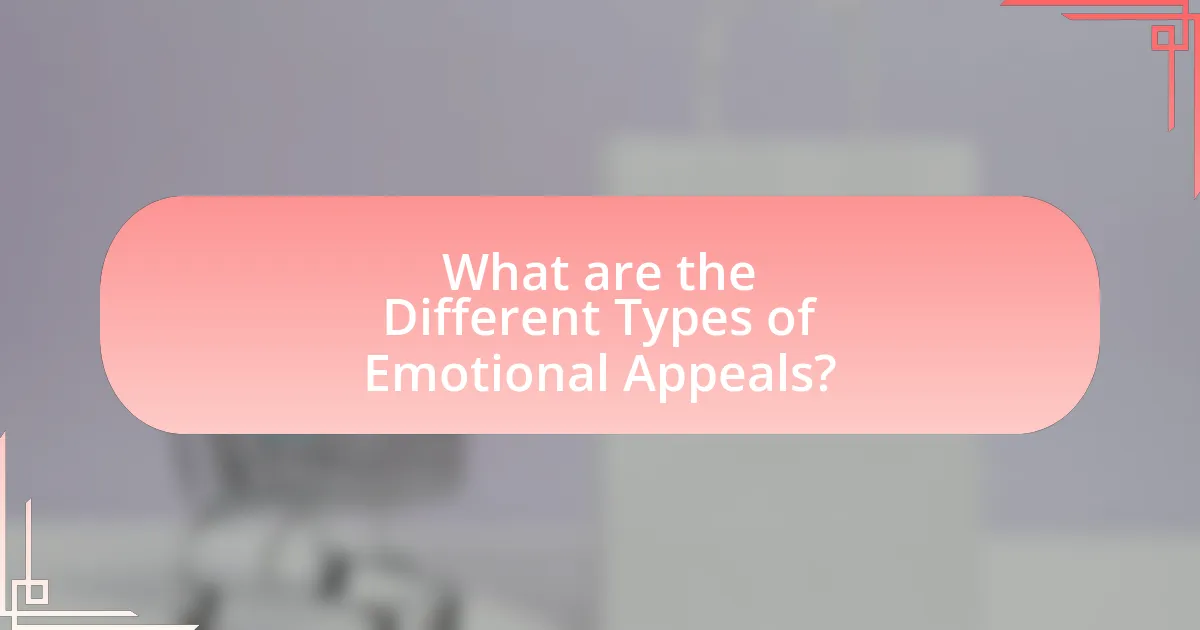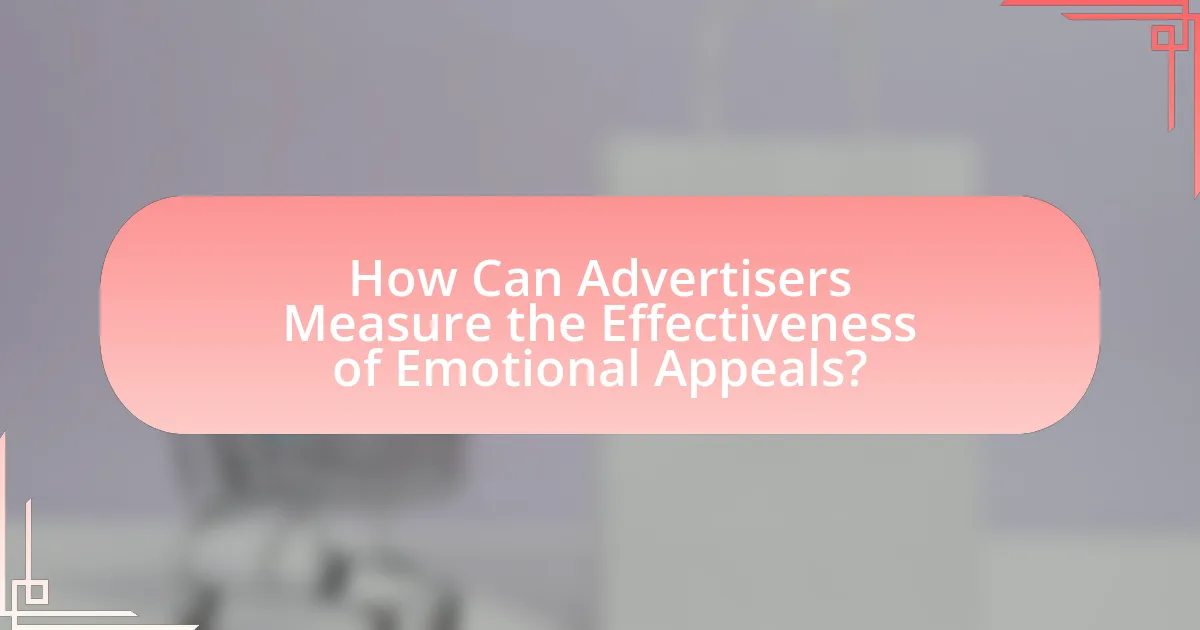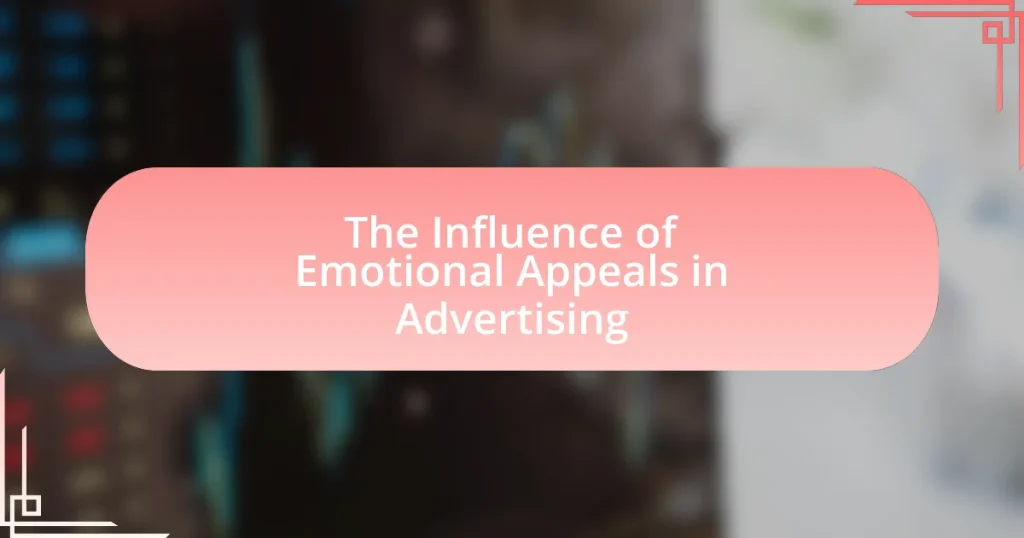Emotional appeals in advertising are strategies designed to evoke specific feelings, such as happiness, fear, sadness, or nostalgia, to influence consumer behavior and decision-making. Research shows that advertisements employing emotional appeals can significantly enhance engagement, brand recall, and purchase intent, with studies indicating a 23% increase in sales effectiveness compared to rational appeals. The article explores various types of emotional appeals, their impact on consumer behavior, the psychological principles behind them, and the effectiveness of humor and fear in advertising. Additionally, it discusses best practices for advertisers to ensure authenticity and relevance in their emotional messaging, as well as methods for measuring the effectiveness of these appeals.

What are Emotional Appeals in Advertising?
Emotional appeals in advertising are strategies that evoke specific feelings to influence consumer behavior and decision-making. These appeals leverage emotions such as happiness, fear, sadness, or nostalgia to create a connection between the consumer and the product or brand. Research indicates that advertisements utilizing emotional appeals can increase engagement and brand recall, with studies showing that emotional content is more likely to be shared and remembered than purely informational content. For instance, a study published in the Journal of Advertising Research found that ads that elicited strong emotional responses had a 23% higher recall rate compared to those that did not.
How do emotional appeals influence consumer behavior?
Emotional appeals significantly influence consumer behavior by triggering feelings that drive purchasing decisions. When advertisements evoke emotions such as happiness, nostalgia, or fear, they create a connection between the consumer and the product, making it more memorable. Research indicates that emotionally charged advertisements can increase purchase intent by up to 23% compared to those that rely solely on rational appeals. This is supported by a study published in the Journal of Advertising Research, which found that emotional responses to ads lead to higher engagement and brand loyalty. Thus, emotional appeals effectively shape consumer behavior by fostering emotional connections that enhance brand perception and influence buying choices.
What types of emotions are commonly targeted in advertising?
Advertising commonly targets emotions such as happiness, fear, sadness, and nostalgia. Happiness is often used to create positive associations with a product, as seen in campaigns that showcase joyful moments. Fear is leveraged to highlight potential negative outcomes if a product is not used, effectively motivating consumers to take action. Sadness can evoke empathy and connection, making the audience more receptive to the brand’s message. Nostalgia taps into fond memories, encouraging consumers to associate those feelings with the product being advertised. Research indicates that emotional appeals can significantly enhance consumer engagement and decision-making, as demonstrated in studies like “The Role of Emotion in Advertising” by Pham and Avnet, which shows that emotional responses can influence purchasing behavior.
How do different emotions affect purchasing decisions?
Different emotions significantly influence purchasing decisions by affecting consumer behavior and motivation. For instance, positive emotions like happiness and excitement can lead to impulsive buying, as consumers are more likely to make spontaneous purchases when they feel good. Conversely, negative emotions such as fear or sadness can drive consumers to seek comfort through products, often leading to purchases that provide emotional relief. Research by the Journal of Consumer Research indicates that emotional appeals in advertising can increase purchase intentions by 23% when they resonate with the target audience’s feelings. This demonstrates that understanding and leveraging emotions in marketing strategies can effectively enhance consumer engagement and drive sales.
Why are emotional appeals effective in advertising?
Emotional appeals are effective in advertising because they create a strong connection between the consumer and the brand, influencing purchasing decisions. This effectiveness stems from the ability of emotions to drive behavior; studies show that emotional responses can lead to a 23% increase in sales compared to rational appeals. Furthermore, emotional advertising often enhances brand recall and fosters customer loyalty, as consumers are more likely to remember ads that evoke feelings such as happiness, nostalgia, or empathy. For instance, a 2015 study published in the Journal of Advertising Research found that ads eliciting emotional responses were more likely to be shared on social media, amplifying their reach and impact.
What psychological principles underpin emotional appeals?
Emotional appeals in advertising are underpinned by several psychological principles, including the principles of affective reasoning, social proof, and the scarcity principle. Affective reasoning suggests that emotions significantly influence decision-making, leading consumers to make choices based on feelings rather than rational analysis. Social proof indicates that individuals are more likely to adopt behaviors or beliefs if they see others doing the same, which can be leveraged in advertisements that evoke shared emotional experiences. The scarcity principle posits that perceived scarcity increases the value of an item, making emotional appeals more compelling when they highlight limited availability or urgency. These principles are supported by research, such as the findings from Cialdini’s work on influence, which demonstrate how emotional triggers can effectively sway consumer behavior.
How do emotional appeals create brand loyalty?
Emotional appeals create brand loyalty by forging strong connections between consumers and brands through feelings of trust, nostalgia, or happiness. When brands evoke emotions, they enhance consumer engagement and foster a sense of belonging, which leads to repeat purchases. Research indicates that emotionally connected customers are more likely to remain loyal, with a study by the Harvard Business Review showing that emotionally engaged customers are three times more likely to recommend a brand and four times more likely to repurchase. This demonstrates that emotional appeals not only influence immediate purchasing decisions but also cultivate long-term loyalty.

What are the Different Types of Emotional Appeals?
The different types of emotional appeals include fear, happiness, sadness, anger, and surprise. Fear appeals aim to evoke anxiety or concern, often used in public health campaigns to encourage behavior change, such as anti-smoking advertisements that highlight health risks. Happiness appeals focus on positive emotions, commonly seen in advertisements for products that promise joy or satisfaction, like vacations or luxury items. Sadness appeals evoke empathy and compassion, often utilized in charity campaigns to encourage donations by showcasing the plight of those in need. Anger appeals can provoke a strong emotional response, frequently used in social justice campaigns to mobilize action against perceived injustices. Lastly, surprise appeals capture attention through unexpected elements, often used in creative advertising to engage viewers and enhance brand recall. Each type of emotional appeal is strategically employed in advertising to influence consumer behavior and decision-making.
How do fear-based appeals work in advertising?
Fear-based appeals in advertising work by leveraging the emotional response of fear to motivate consumers to take action, such as purchasing a product or service. These appeals typically highlight potential threats or negative consequences that could occur if the consumer does not act, thereby creating a sense of urgency. Research indicates that fear can enhance message retention and increase the likelihood of behavioral change, as seen in studies where fear-inducing messages led to higher compliance rates in health-related campaigns. For example, a study published in the Journal of Advertising Research found that fear appeals can effectively increase the intention to adopt preventive health behaviors when combined with actionable solutions.
What are the potential risks of using fear in advertising?
Using fear in advertising can lead to several potential risks, including desensitization, backlash, and negative brand perception. Desensitization occurs when audiences become accustomed to fear-based messages, reducing their effectiveness over time. Research indicates that repeated exposure to fear appeals can lead to diminished emotional responses, making consumers less likely to engage with future campaigns. Backlash can arise when consumers perceive fear tactics as manipulative or unethical, resulting in a loss of trust and loyalty towards the brand. A study published in the Journal of Advertising found that fear appeals can sometimes provoke anger or resentment, leading to adverse reactions. Additionally, negative brand perception can stem from fear-based advertising, as consumers may associate the brand with anxiety or distress rather than positive attributes. This association can hinder brand reputation and customer relationships, ultimately impacting sales and market position.
How can fear-based appeals be used effectively?
Fear-based appeals can be used effectively by creating a sense of urgency and highlighting potential negative consequences if the audience does not take action. For instance, advertisements that emphasize the dangers of smoking often showcase graphic images of health issues, which can lead to increased awareness and behavioral change. Research by the American Psychological Association indicates that fear appeals can motivate individuals to adopt healthier behaviors when they perceive a high level of susceptibility and severity related to the threat presented. This approach is most effective when combined with clear, actionable steps for the audience to mitigate the fear, thereby empowering them to respond positively.
What role does humor play in emotional appeals?
Humor plays a significant role in emotional appeals by enhancing engagement and creating a positive emotional response. When humor is effectively integrated into advertising, it captures attention and fosters a connection between the audience and the message. Research indicates that humorous content can increase recall and persuasion; for instance, a study published in the Journal of Advertising found that humorous ads are more likely to be remembered and shared, leading to higher brand recognition. This positive emotional state can also reduce resistance to the message, making consumers more receptive to the underlying product or service being promoted.
How does humor impact consumer engagement?
Humor significantly enhances consumer engagement by capturing attention and fostering positive emotional responses. When advertisements incorporate humor, they create a memorable experience that encourages sharing and discussion among consumers. Research indicates that humorous content can increase brand recall by up to 50%, as consumers are more likely to remember ads that evoke laughter. Additionally, a study published in the Journal of Advertising Research found that humor not only boosts engagement but also positively influences consumers’ attitudes toward the brand, leading to increased purchase intentions.
What are the challenges of using humor in advertising?
The challenges of using humor in advertising include the risk of misinterpretation, cultural differences, and the potential to distract from the product message. Misinterpretation can occur when humor is not universally understood, leading to confusion about the brand’s intent. Cultural differences can affect how humor is perceived; what is funny in one culture may be offensive or irrelevant in another, potentially alienating target audiences. Additionally, humor can overshadow the product message, causing consumers to remember the joke rather than the brand or its benefits. Research indicates that while humor can enhance recall, it must be carefully aligned with the brand’s identity to avoid these pitfalls.

How Can Advertisers Measure the Effectiveness of Emotional Appeals?
Advertisers can measure the effectiveness of emotional appeals through various methods, including surveys, focus groups, and biometric analysis. Surveys can quantify emotional responses by asking consumers to rate their feelings after exposure to an advertisement, while focus groups provide qualitative insights into emotional engagement. Biometric analysis, such as tracking eye movement and measuring physiological responses like heart rate or skin conductance, offers objective data on emotional reactions. Research by the Nielsen Company indicates that ads eliciting strong emotional responses can lead to a 23% increase in sales effectiveness, demonstrating the tangible impact of emotional appeals.
What metrics are used to evaluate emotional appeal effectiveness?
Metrics used to evaluate emotional appeal effectiveness include emotional response measurement, engagement metrics, brand recall, and purchase intent. Emotional response measurement often utilizes tools like facial coding and biometric analysis to assess viewers’ emotional reactions to advertisements. Engagement metrics, such as click-through rates and social media interactions, indicate how well an emotional appeal resonates with the audience. Brand recall is measured through surveys that assess how well consumers remember the brand after exposure to the ad, while purchase intent is gauged through consumer surveys that ask about the likelihood of buying the product after viewing the advertisement. These metrics collectively provide a comprehensive understanding of how effectively emotional appeals influence consumer behavior.
How can surveys and focus groups provide insights into emotional responses?
Surveys and focus groups can provide insights into emotional responses by directly capturing participants’ feelings and attitudes towards specific stimuli, such as advertisements. Surveys often include scaled questions that quantify emotional reactions, while focus groups facilitate in-depth discussions that reveal the nuances of emotional engagement. Research indicates that qualitative data from focus groups can uncover underlying motivations and emotional triggers that quantitative surveys may overlook. For instance, a study by Hagtvedt and Brasel (2017) published in the Journal of Consumer Research demonstrates that emotional responses significantly influence consumer behavior, highlighting the importance of understanding these reactions through targeted research methods.
What role does social media play in measuring emotional engagement?
Social media serves as a critical tool for measuring emotional engagement by providing real-time feedback through user interactions such as likes, shares, comments, and reactions. These metrics allow brands to assess the emotional resonance of their content, as studies indicate that posts eliciting strong emotional responses tend to generate higher engagement rates. For instance, research published in the Journal of Advertising Research found that emotionally charged content can increase sharing by up to 30 times compared to neutral content. This quantifiable data enables marketers to refine their strategies based on audience sentiment, ultimately enhancing the effectiveness of emotional appeals in advertising.
What best practices should advertisers follow when using emotional appeals?
Advertisers should ensure authenticity and relevance when using emotional appeals. Authenticity fosters trust, as consumers are more likely to respond positively to genuine emotions rather than manipulative tactics. For instance, a study by the Journal of Advertising Research found that emotionally authentic ads can increase brand loyalty by up to 23%. Additionally, relevance to the target audience enhances the effectiveness of emotional appeals; ads that resonate with the audience’s values and experiences are more impactful. Research from the Harvard Business Review indicates that emotionally connected customers are 52% more valuable than those who are just satisfied. Therefore, advertisers must prioritize authenticity and relevance to maximize the effectiveness of emotional appeals.
How can advertisers ensure authenticity in emotional messaging?
Advertisers can ensure authenticity in emotional messaging by utilizing genuine storytelling that resonates with the target audience’s experiences and values. This approach involves conducting thorough audience research to understand their emotional triggers and crafting narratives that reflect real-life situations, thereby fostering a sense of relatability. For instance, a study by the Journal of Advertising Research found that ads featuring authentic emotional stories led to a 30% increase in consumer engagement compared to those that relied on exaggerated or fabricated emotions. By prioritizing transparency and aligning brand values with the emotional narratives presented, advertisers can build trust and enhance the effectiveness of their emotional appeals.
What strategies can enhance the impact of emotional appeals in campaigns?
To enhance the impact of emotional appeals in campaigns, utilizing storytelling is a highly effective strategy. Storytelling engages audiences by creating relatable narratives that evoke emotions, making the message more memorable. Research indicates that narratives can increase information retention by up to 65%, as they allow individuals to connect personally with the content. Additionally, incorporating visuals that resonate emotionally can amplify the message; studies show that emotional images can increase viewer engagement by 95%. Furthermore, aligning the emotional appeal with the target audience’s values and beliefs ensures greater relevance, leading to a 30% increase in campaign effectiveness. These strategies collectively strengthen the emotional resonance of campaigns, driving consumer action and loyalty.


